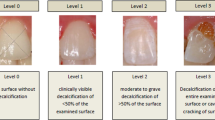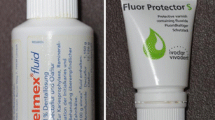Abstract
Objective:
To investigate the incidence of white spot lesions (WSLs) around brackets and molar bands during orthodontic therapy, and establish whether a correlation to indices of dental and gingival health, fluoride application and oral hygiene could be demonstrated.
Patients and Methods:
Fifty-three patients with fixed orthodontic appliances were included at random in this study at the Department of Orthodontics of Erlangen-Nuremberg University. Dental health (DMFS), plaque index, papillary bleeding index, sulcus probing depth (SPD), gingival recession (GR), clinical attachment level (as sum of SPD and GR), oral hygiene, and fluoride use were evaluated. WSLs were graded from intraoral photographs taken before and after treatment.
Results:
97.5% of teeth before and 73.6% after treatment were free of WSLs. Of all teeth, 24.9% developed new WSLs or a rise in their number. New or more numerous WSLs were more common in upper and lower premolars (34.4%) and front teeth (28.1%) than molars (11.8%). WSL incidence during therapy correlated with clinical attachment level, and the oral hygiene and fluoride-use scores.
Conclusions:
Despite improvements in materials and preventive efforts, orthodontic treatment continues to carry the considerable risk of enamel demineralization. Each patient's prophylactic efforts, including fluoride use, are of paramount importance in preventing WSLs.
Zusammenfassung
Ziel:
Ziel der Studie war es, die Inzidenz von „white spot lesions“ (WSLs) um Brackets und Molarenbänder während der kieferorthopädischen Behandlung festzustellen sowie zu prüfen, ob ein Zusammenhang mit Indices der dentalen und gingivalen Gesundheit, der Fluoridanwendung und der Mundhygiene zu erkennen ist.
Patienten und Methodik:
Es wurden 53 Patienten mit festsitzender Multibracketapparatur der Zahnklinik 3 – Kieferorthopädie der Universität Erlangen-Nürnberg randomisiert ausgewählt. Zahngesundheit (DMFS), Plaque-Index, Papillen-Blutungs-Index, Sondierungstiefe (SPD), gingivale Rezession (GR), klinischer Attachmentlevel als Summe aus SPD und GR, Mundhygienegewohnheiten sowie der Umfang häuslicher Fluoridanwendungen wurden erhoben. Der Grad der WSLs wurde anhand intraoraler Fotografien vor und nach der kieferorthopädischen Behandlung dokumentiert und bewertet.
Ergebnisse:
97.5 % der Zähne wiesen vor, 73.6% nach der Behandlung keine WSLs auf. Bei 24.9% aller Zähne entstanden neue oder ausgedehntere WSLs. Die Zunahme von WSLs betraf besonders die Prämolaren (34.4%) und die Frontzähne (28.1%), weniger die Molaren (11.8%) des Ober- und Unterkiefers. Die Inzidenz der WSL swährend der kieferorthopädischen Behandlung korrelierte mit dem klinischen Attachmentlevel und den Scores für Mundhygiene und Fluoridgebrauch.
Schlussfolgerungen:
Trotz der Weiterentwicklung der kieferorthopädischen Materialien und der Präventionsmaßnahmen birgt die festsitzende kieferorthopädische Therapie weiterhin ein erhebliches Risiko der Schmelzdemineralisation. Zur Prophylaxe bleibt die optimierte Mundhygiene der Patienten unter Einschluss der häuslichen Fluoridierung von wesentlicher Bedeutung.
Similar content being viewed by others
Author information
Authors and Affiliations
Corresponding author
Rights and permissions
About this article
Cite this article
Lovrov, S., Hertrich, K. & Hirschfelder, U. Enamel Demineralization during Fixed Orthodontic Treatment – Incidence and Correlation to Various Oral-hygiene Parameters. J Orofac Orthop 68, 353–363 (2007). https://doi.org/10.1007/s00056-007-0714-1
Received:
Accepted:
Issue Date:
DOI: https://doi.org/10.1007/s00056-007-0714-1




